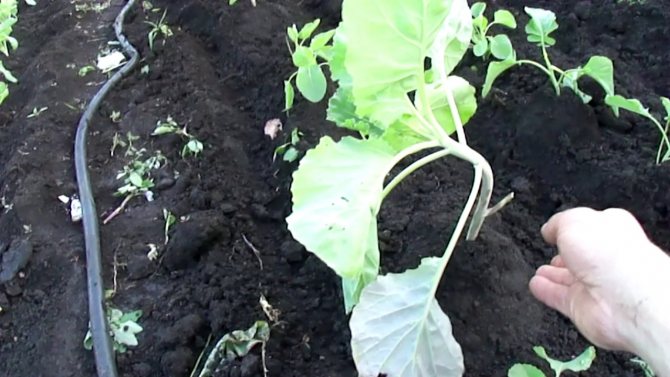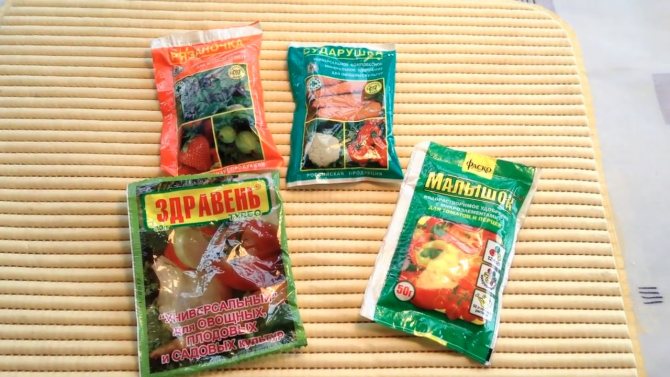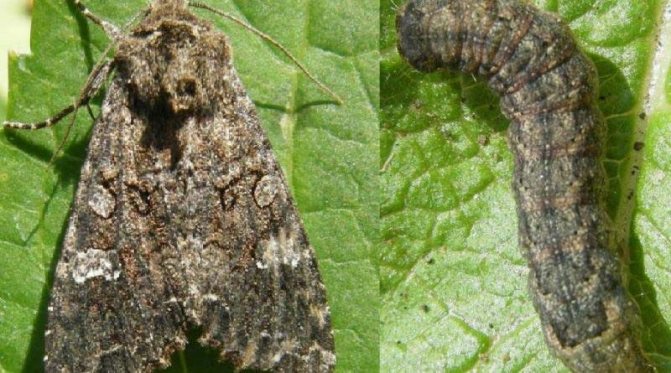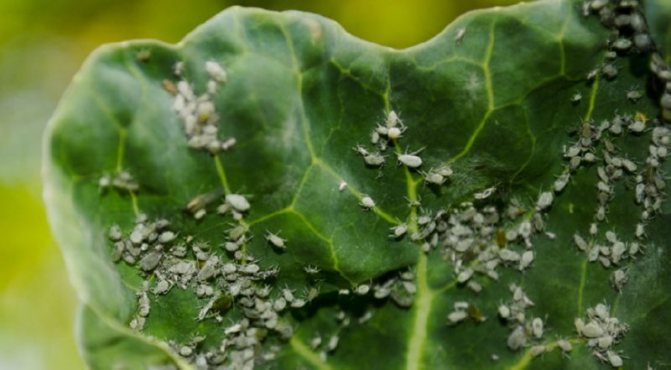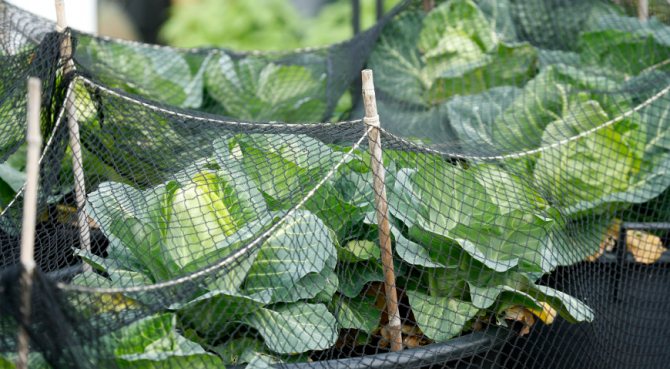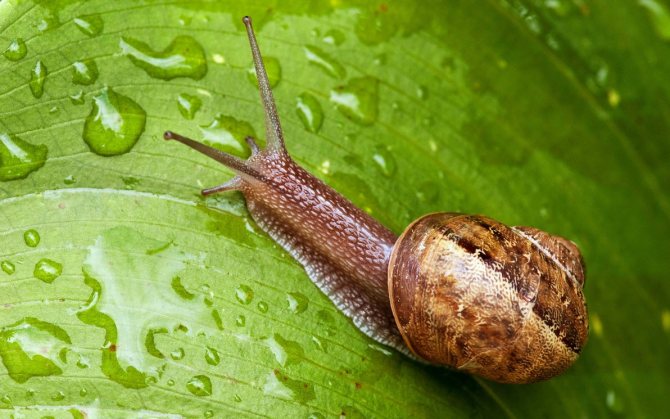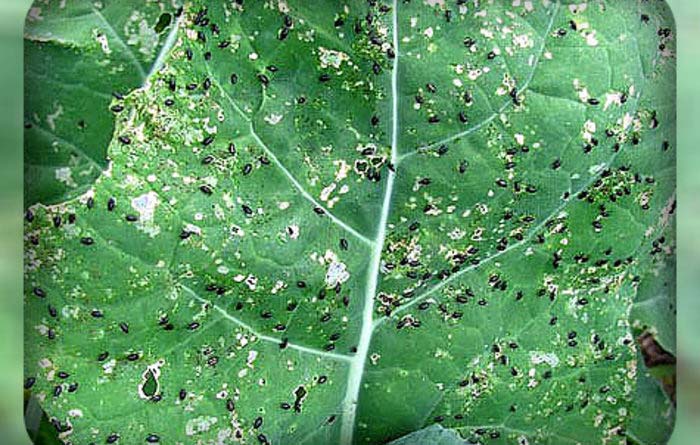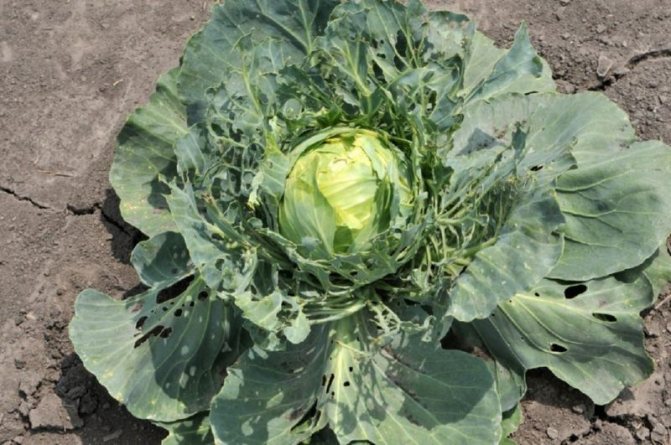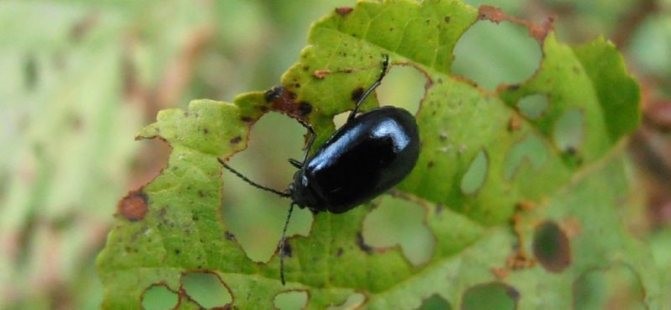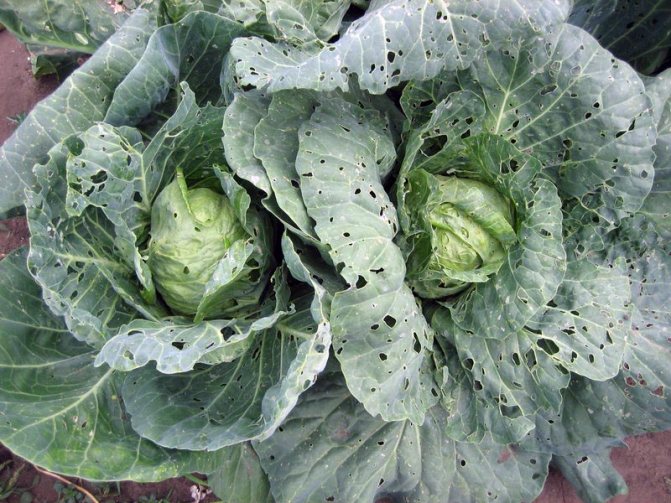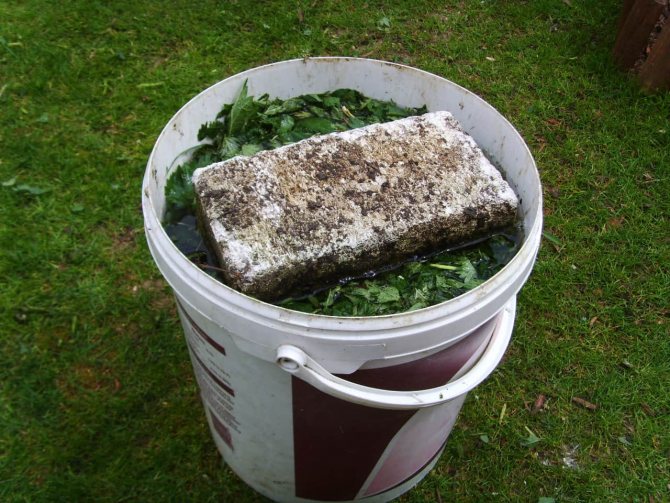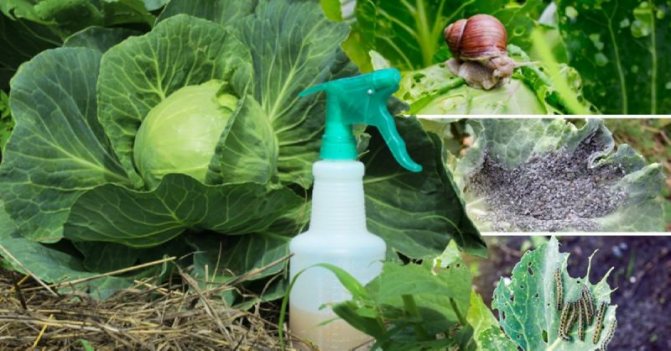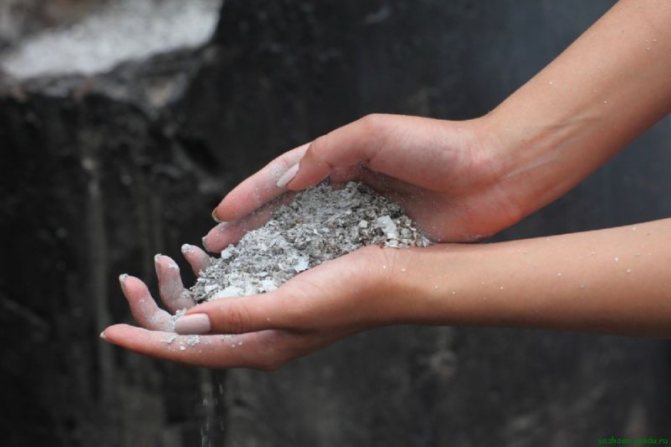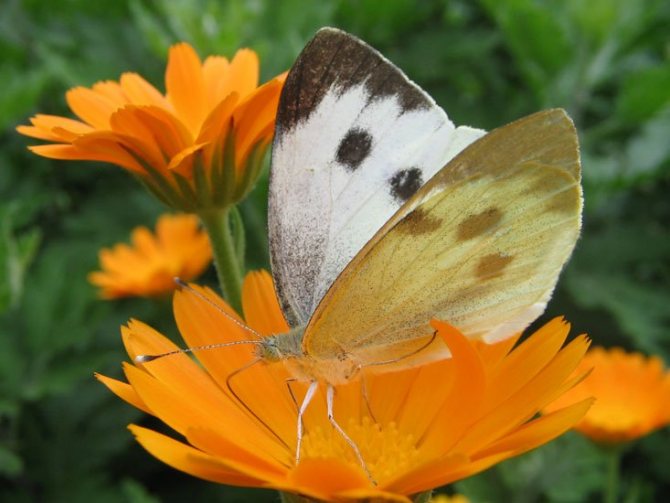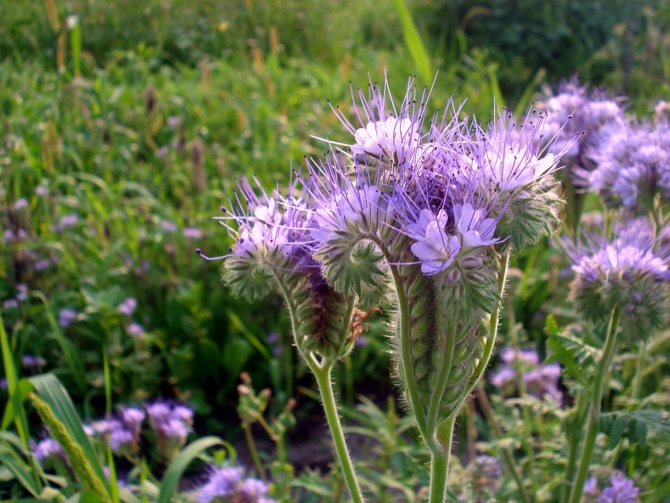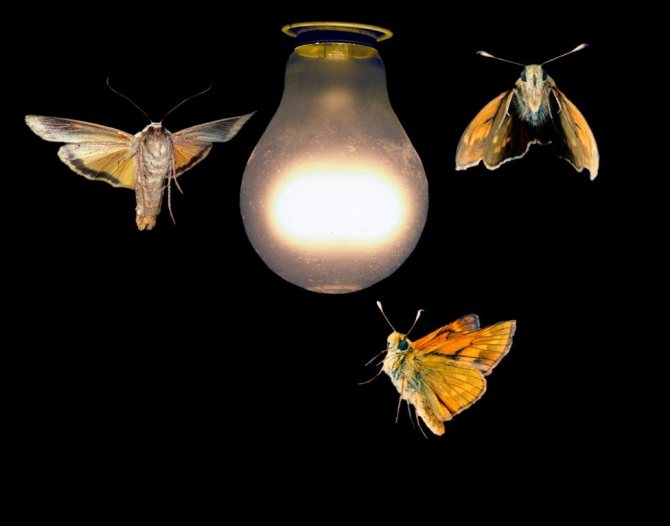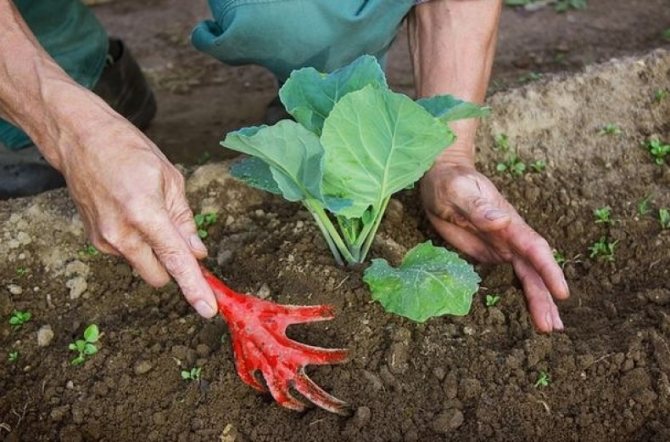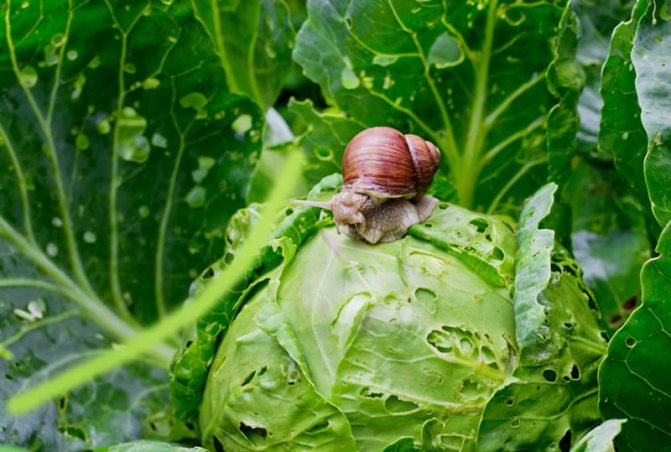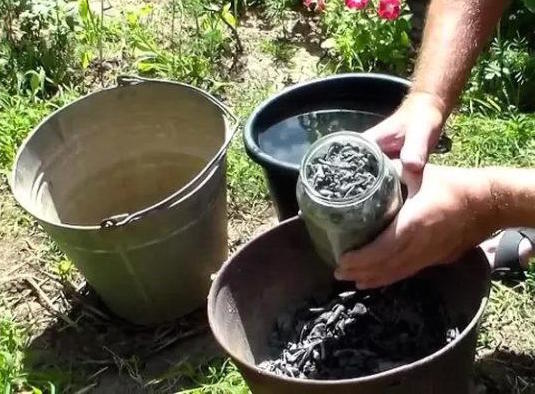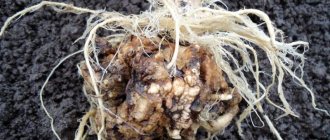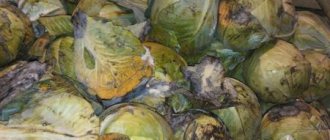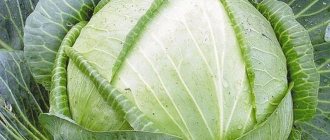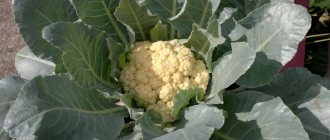Author rating
The author of the article
Yakov Pavlovich
Professor, Head of the Department of Vegetable Growing
Articles written
153
In order not to lose the harvest and to collect large juicy heads of cabbage by autumn, you need to know how experienced gardeners treat cabbage from pests. After all, this vegetable is very attractive for aphids, caterpillars, butterflies, beetles, slugs. In addition to spraying the soil and seedlings with chemicals, you can use folk recipes, agricultural methods, and special protection of the plant from invasions of parasites.
Gnawing pests
What kind of insects do not want to feast on delicious and crispy cabbage, its young shoots and roots. Pests such as bear, snails, cabbage fly, cabbage scoop and others come running to the smell of cruciferous, flock and slide.
Cabbage scoop
A nondescript butterfly with dirty brown wings poses a serious threat to cabbage plantations. Despite its modest size (its body does not exceed 25 mm, and its wingspan is 40-50 mm), it has incredible fertility. During her life, each female lays up to 2500 eggs.
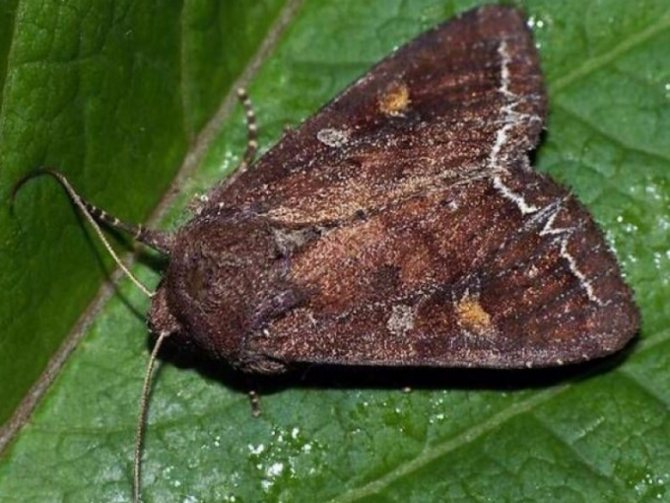
Cabbage scoop - small nondescript brown butterfly
The cabbage scoop prefers to settle near rivers and lakes. High humidity and warm weather are ideal conditions for massive population development. Conversely, a moisture deficit leads to the death of caterpillars and to a decrease in the fertility of butterflies. Another prerequisite for the breeding of the cabbage scoop is the presence of flowering crops nearby. In the absence of sweet nectar in the diet, they almost completely lose the ability to reproduce offspring.
Note! Under favorable conditions, one clutch of a cabbage scoop may contain up to 150 eggs... In critical situations, the number of eggs decreases up to 20-30 pieces.
Massive emergence of the cabbage scoop from the shelters is observed in late spring - early summer. And after two days, the butterflies are ready to mate and lay eggs. They place the clutches on the lower leaves of the cabbage from the back. That is why gardeners do not immediately find unpleasant neighbors.
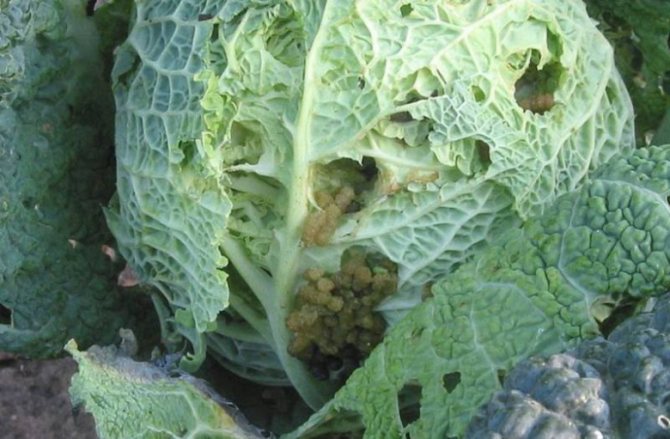

Cabbage scoop larvae can completely spoil an already ripe head of cabbage
Caterpillars are born after 5–12 days and immediately begin to gnaw on juicy leaves. At the first stage of development, small pests are capable of damaging only the lower part of the leaf blades. But already in the 2nd and 3rd stages of growth, they begin to eat through holes, and the damage from their presence becomes obvious.
Adult caterpillars reaching length 40-50 mm, gnaw real tunnels in heads of cabbage, gradually filling them with the products of their vital activity.
Cruciferous flea
Despite the epic name, these pests have nothing to do with real fleas. Small black bugs on cabbage got their nickname because of their ability to jump long distances. Cruciferous fleas that overwintered in the upper soil layer emerge from their shelters in mid-April.
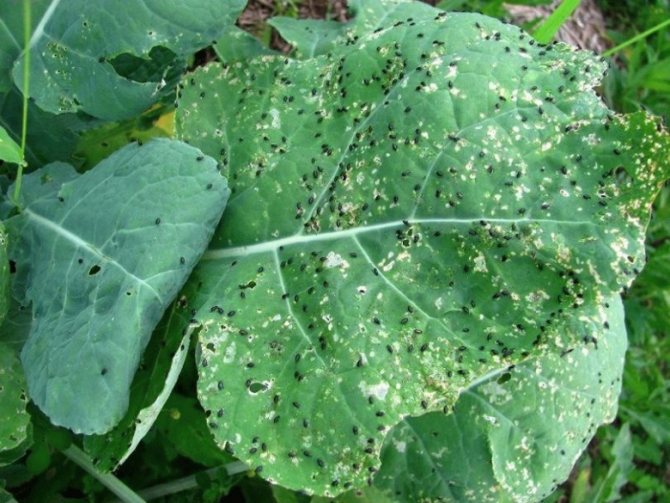

Cruciferous fleas are black bugs that briskly jump between plants
During this period, gardeners still do not have time to sow their plantations, and the bugs have to feed on weeds.But as soon as representatives of the cruciferous family appear on the beds, small pests move to them. Beetles gladly skeletonize juicy cabbage seedlings.
In May-June, females begin to form clutches, from which larvae hatch after 1-2 weeks. A few hours later, small gluttonous pests gnaw through the top layer of the leaf and rush inward, eating mines in it. With this method of feeding, the larvae damage only the inner part of the leaf blade, and the outer layers are left intact.
Note! If you look closely at the damaged leaves, you can see the passages left by the cruciferous flea beetle larvae.
Pupation takes place in the soil. Starting from the second half of summer, young adults are selected on the soil surface. During this period, they are especially dangerous. Hungry and voracious cruciferous fleas, huddling in huge flocks, can completely destroy a cabbage head in a few days.
Cabbage fly
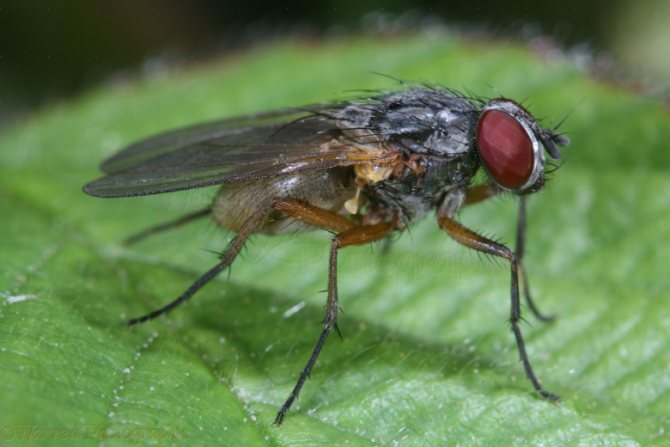

Cabbage fly annoys gardeners from the first days of field work
- The color of the imago ranges from light ash to gray.
- Body length from 5.5 to 7 mm;
- The larva is white, up to 8 mm long.
At the end of April, when the soil warms up to +12 C, gardeners start planting white cabbage seedlings. At the same time, cabbage pests in the open field - overwintered cabbage flies - are selected from the ground. After 10 to 15 days, they begin to lay their first eggs.
Note! During the season, each female lays at least 150 eggs.
The cabbage fly prefers to settle its offspring in clay, lumpy areas, hiding its eggs in small cracks near strong healthy plants. But flies avoid sandy, crumbly soils. They do not like mulched beds either.
The larvae penetrate the root and eat away at its middle, and then after 30 days they go back into the soil. The second mass flight of flies is observed in July.
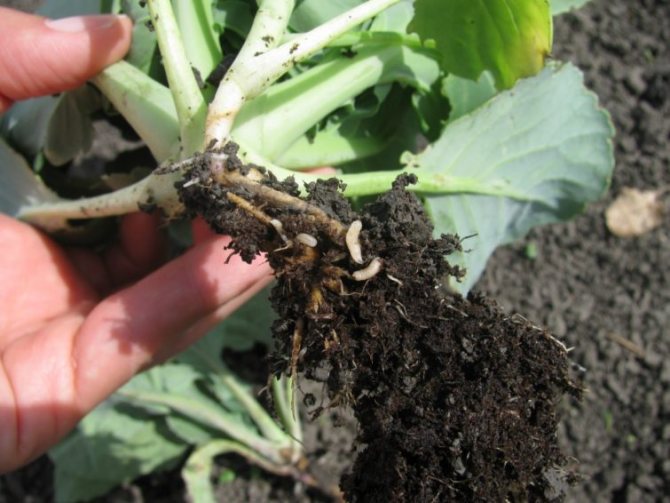

Cabbage fly larvae gnaw cabbage roots and slow down plant development
The fact that non-requested guests were brought up on the site can be determined by the appearance of the seedlings.
- Plants are significantly lagging behind in growth.
- Leaves lose tugur.
- Bluish-lead shades appear in the color of the leaf plates.
Cabbage white
In early spring, in the gardens, you can see a beautiful butterfly with milky-white wings bordered by a black stripe.
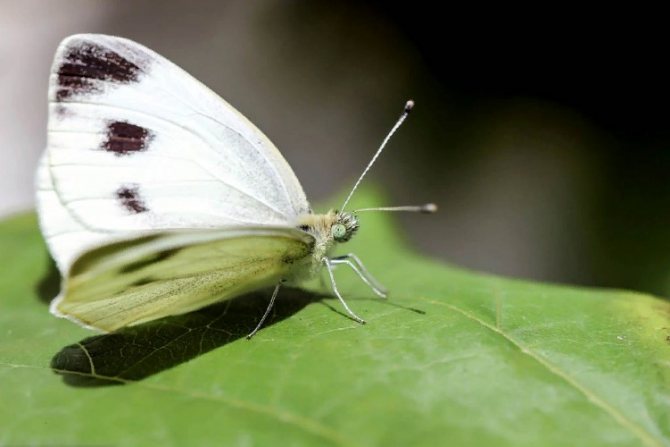

The beautiful white butterfly gives a lot of trouble to gardeners
Cabbage or cabbage white lays eggs on the lower part of the leaf plates at their very base. Her clutches are large enough, 100-200 eggs each. At first, the hatched caterpillars all live together and together eat the tender juicy flesh from the back of the leaf plates.
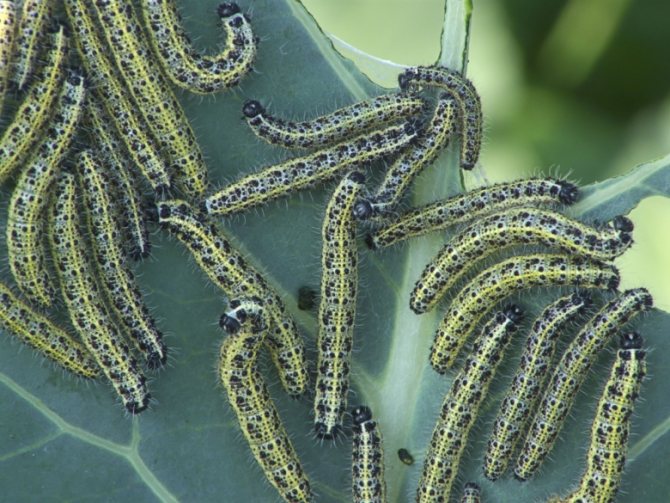

Caterpillars of cabbage whites can completely gnaw a head of cabbage in a few days.
After 2 molts, the caterpillars spread out. At this age, they no longer just violate the integrity of the epidermis, but also gnaw through rather large holes in the leaves. At the last stage of development, caterpillars are capable of damaging not only white cabbage, but also cauliflower, having laid several winding passages through the entire head.
Cabbage moth
Gray, inconspicuous butterflies, predominantly nocturnal, bring cabbage no less harm. The cabbage moth does not differ in excessively high fertility; it lays no more than 300 eggs in its entire life. But here the massive years of this moth can be observed during the entire summer season. The full growth cycle of insects occurs in 45–55 days. During the spring - summer period, up to 6 generations can change.
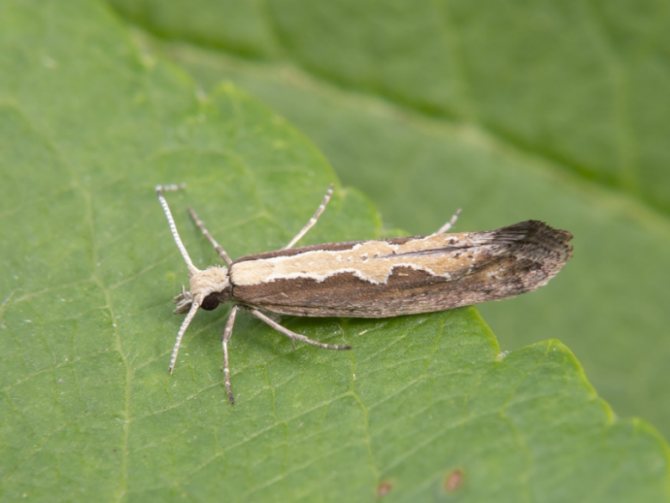

An inconspicuous doll moth can destroy all the flesh from the head to the leaves
- Color from gray to brownish brown.
- The wingspan is from 11 to 16 mm.
- The larvae are green, sometimes brown, up to 11 mm long.
In the first period of life, caterpillars live inside leaf plates. But after 5-6 days they get out of the mines and settle under the lower leaves. After 3-4 molts, the caterpillars go to the center of the head of cabbage and quickly destroy the tender pulp, while constructing silk curtains for themselves. Pupation occurs on the same plant. The butterfly that emerged from the cocoon immediately engages in the reproduction process.
Wireworm
Wireworms in our area are usually called the larvae of all click beetles. Small earthworms, covered with a dense chitinous shell, got their nickname for their resemblance to pieces of copper wire. The larvae live in the soil layer and gnaw any vegetables and grain crops with pleasure.
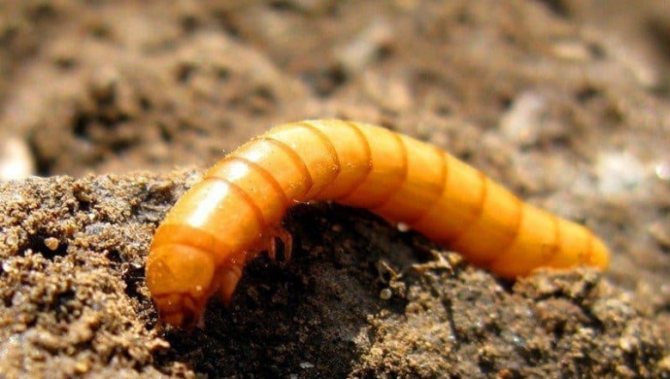

The larvae of click beetles got their name for the similarity with copper wire
Due to the special structure of the food apparatus - wireworms are able to assimilate only liquid fractions - they gnaw much more plant food than they are able to physically consume. Wireworms can:
- completely nibble thin roots;
- penetrate into the central root and eat away its inner part;
- climb the stem above the soil level.
After such damage, plants cannot consume micro and macro elements dissolved in the soil.
Medvedka
Medvedka, better known as cabbage or earthen crayfish, gives gardeners no less problems than an invasion of caterpillars. Nimble insects, digging winding labyrinths under the beds, gnaw at the roots and destroy all vegetation in their path.
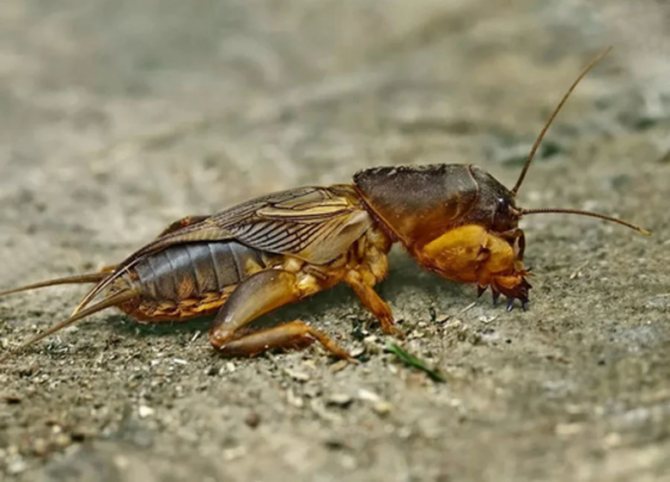

Laying winding passages under the bed, the bear gnaws at the roots of cabbage seedlings
Adults reach 45-50 mm in length, have well-developed digging legs (front pair) crowned with powerful teeth - claws.
Note! Despite the fact that they lead an underground lifestyle, they are excellent swimmers. Grabbing a small twig, they can float down the river or move with melt water. Bears can even fly. But if males practically do not use this skill, then females, on the contrary, very often fly from one site to another in search of food and a place for arranging the masonry.
Cabbage males are the only insects that decorate their dwellings in the form of a musical horn. Due to this structure of the mink, the sounds made by the male are clearly audible even at a distance of several kilometers. Hearing the evening trills of an earthen crayfish, female bear cubs flock to his dwelling from all over the area. The most vociferous singers can lure up to 20 females in one evening.
Note! It is not at all difficult to recognize the dwelling of the male. If you notice 3 entrance holes at once, located in the form of a triangle at a distance of 10 - 15 cm from each other, you should know that an earth crust has settled here.
Mass emergence of adults is observed after the soil surface warms up to 12–15 ° С. However, there are also those that wake up as soon as the ground temperature reaches 8-10 degrees. Insects start mating immediately. Usually each female leaves 60–80 eggs, but sometimes clutches are found in which the number of eggs reaches 300 pieces.
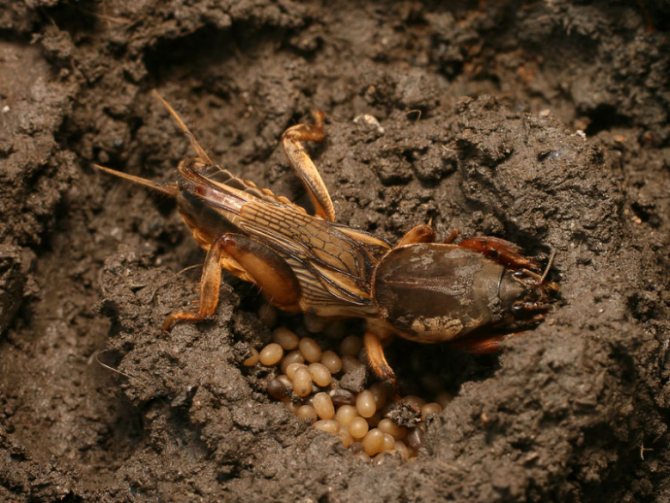

The most fertile female bears can lay up to 300 eggs.
Larvae, similar to small spiders, are born in June - July. For the first few weeks, the offspring is under the supervision of the female, and after 20 days they scatter around the site. At the first age, the larvae feed on humus, but after a month they switch to adult food and begin to gnaw the roots of plants and eat soil insects. Larvae and adults hibernate in the ground under manure and compost heaps.
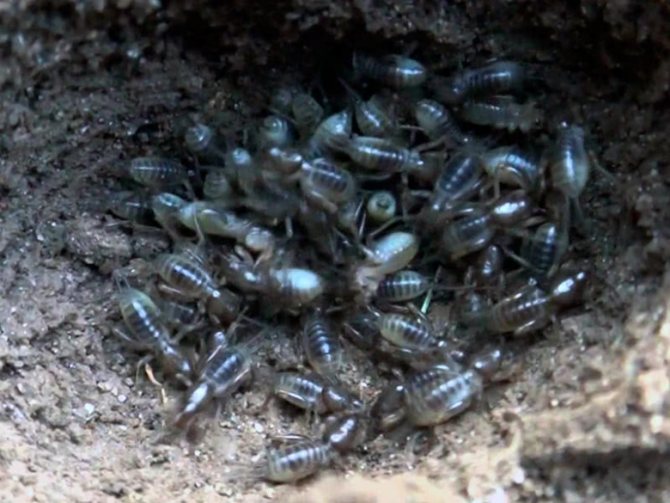

The bear larvae look like transparent spiders
Slugs and snails
Slugs and snails don't just gnaw at the outermost cabbage leaves.They gnaw deep tunnels and live for a long time in the middle of the head of cabbage, thereby deteriorating its quality, presentation and shelf life. Most of them are carriers of flukes and nematodes.
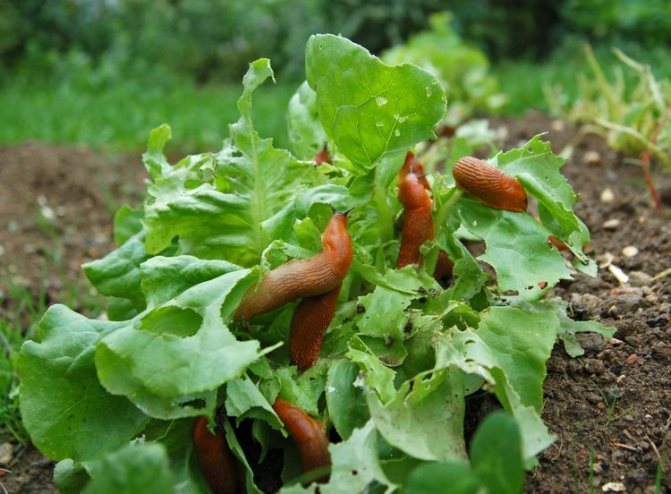

Gluttonous slugs and snails at night also come to feast on juicy cabbage
Both pests are predominantly nocturnal, but in years with heavy rainfall and high humidity they can move in search of food even in the daytime. Under favorable conditions, colonies grow at lightning speed.
The overgrown populations are absolutely not demanding on food and gladly absorb any vegetable, berry and industrial crops. In a few nights, a family of snails or slugs is capable of completely destroying young cabbage stands.
On a note! Baking soda for caterpillar control is a simple, effective remedy!
Colored
Cauliflower varieties are also susceptible to the same pest infestations as common cabbage, so the fight against them is similar to the treatment of a plantation of simple cabbage varieties.
But the best defense is prevention, so to significantly reduce the attacks of harmful insects and crawling snails, take note of these tips:
- Plant garlic around cabbage ridges, its phytoncides will scare off many pests. But what can be planted near garlic, this information will help to understand.
- Heads of dill or tomatoes planted nearby will also protect... Many experienced gardeners often sow dill on purpose, its umbrellas will protect the plants from the attacks of garden pests.
- Plants with a pronounced aroma will also be excellent helpers in protection from aphids, fleas, ticks.... These include, first of all, sage, calendula, mint. They exude scents that most dangerous pests really dislike.
- Cucumber grass, or borage, can also benefit the gardener, its aroma will scare away butterflies and ticks, and even slugs.
Mustard powder helps very well against slug infestation - you just need to sprinkle it around the stump, and your cauliflower will be reliably protected.
If the infection is obvious, and you cannot get rid of the pests in any way, then an ammonia solution will be a very good remedy - dilute 100 ml of the substance in a bucket of water, and process not only the foliage, but also the ground around the plants. But how the Rinda cabbage is sprayed, and what are the best means, is indicated here.
Tobacco dust or simply pounded shag will help scare off the white butterfly, and it is known to lay a large number of eggs, from which gluttonous caterpillars will hatch. Plain vinegar or tobacco infusions will also help you fight for a good cauliflower crop.
Sucking pests
During the season, summer residents have to fight not only with malicious gnawing pests, but also with whole hordes of sucking parasites.
Aphid
If, despite careful care, the cabbage lags behind in growth, and its leaves begin to turn yellow and die off, look carefully at the petioles located in the lower part of the head of cabbage. Aphids may have appeared on the forks.
Note! Many gardeners naively believe that absolutely any aphid can settle on cabbage. However, this is not at all the case. For this vegetable crop, it is the cabbage aphid that poses a danger. This harmful insect is able to feed on the juice of any cruciferous crops, but prefers juicy, elastic heads.
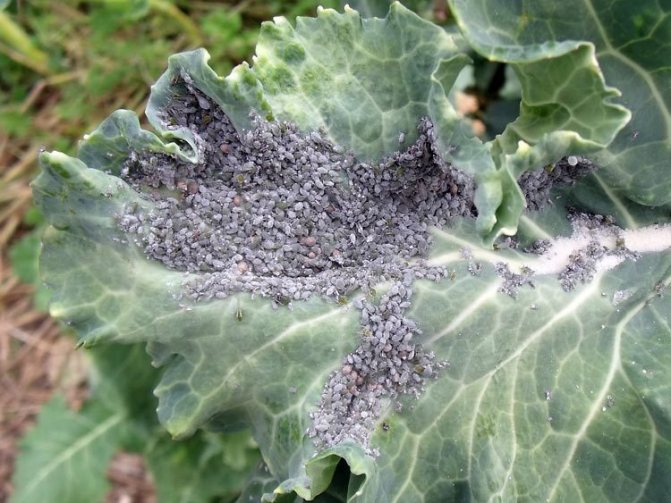

First, the aphid population fills the leaf surface, then sucks all the juice out of the cabbage.
In early spring, a new generation of this superfamily emerges from eggs that overwintered on unharvested cabbage stalks. The founders, as the representatives of the first generation are called, have:
- thick ellipsoidal body no more than 2 mm long;
- pale green color.
Most of the young generation, going in search of food, perishes, only the strongest get to the green vegetation. They instantly stick to juicy stems, then give birth to wingless virgins. Outwardly, the representatives of the second generation practically do not differ from the founders, but they can already give rise to both wingless and winged virgins.
Winged individuals quickly spread throughout the site, and already from them males and females develop. They are the ones that accumulate in large quantities at the bottom of the forks. In autumn, after mating, sexually mature individuals leave ovipositions in the lower part of the cobs.
Absolutely all generations of aphids suck sap from plants, contributing to their wilting, and also spread viral diseases.
Thrips
If all of these pests can be seen even with the naked eye, then with thrips everything is much more complicated. The size of their body, together with the wings, does not exceed 1.5–2 mm. They do not gnaw the leaves, but prick them with thin proboscis-needles and suck life-giving juices from plants.
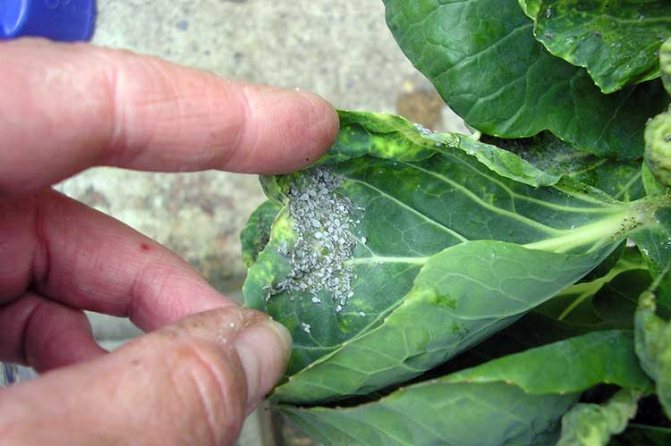

Thrips are so small that they can only be detected by bone signs.
Gardeners will find out that thrips have appeared on the site after small pests have time to spoil part of the crop.
- Change in color of sheet plates.
- Sticky spots dotted with black dots - excrement.
- The appearance of whitish and yellow spots that dry out and crumble over time.
All these are signs of the appearance of thrips on cabbage.
Bedbugs
Cabbage is rarely attacked by bedbugs. However, in the years of overdevelopment of the population, harmful insects that prefer to settle on forage plants do not disdain vegetable crops either.
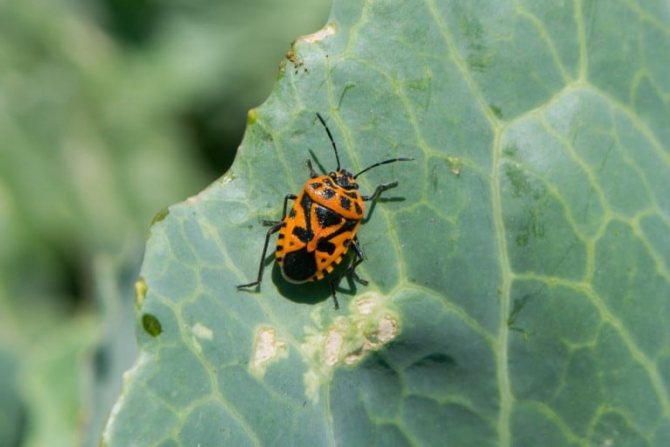

Sometimes even bedbugs arrange their clutches in cabbage.
The adults usually grow up to 8-9 mm in length. They have an elongated green or gray-green body with a transverse head crowned with large antennae.
After the air temperature rises to +18 degrees, the bugs begin to actively reproduce. They lay their eggs in the veins of the stem. Fertility of some females is estimated at 3 hundred eggs. The larvae of the first generation do not practically harm the plants, but after 1 week they enter the next phase of development and begin to actively:
- destroy growth points;
- slow down the growth of leaf plates and the development of seedlings.
Pest control rules
For the fastest and most effective destruction of harmful insects (phytophages), chemical agents are used - insecticides. They act on adults, as well as on eggs and larvae of pests. These are poisonous compounds that are unsafe for humans, so care must be taken when handling them.
Basic rules for pest control:
- Before starting work, you must study the instructions. It is important to strictly adhere to the recommendations indicated in it and observe the dosage.
- Neighboring beds that do not need processing, it is advisable to cover with polyethylene.
- You can spray cabbage in the morning before 10:00 or in the evening after 18:00. The weather should be dry and calm. The optimum air temperature is + 12 ... + 22 ° С.
- The solution is prepared immediately before spraying, it cannot be stored. The containers used for cooking become unsuitable for food.
- The resulting composition must be thoroughly mixed, avoiding the appearance of sediment.
- Processing is carried out in overalls (dressing gown or overalls, headdress, closed shoes). Additionally, rubber gloves, a respirator and goggles are used. After work, you need to wash your hands, face and equipment.
- The duration of the procedure should not exceed 1 hour.
- If it rains within a few hours after its completion, re-spray the solution.If the result is unsatisfactory, for the next treatment, a tool made on the basis of another active substance is used.
Heads of cabbage treated with chemicals should not be eaten earlier than 2-3 weeks after disinfestation.
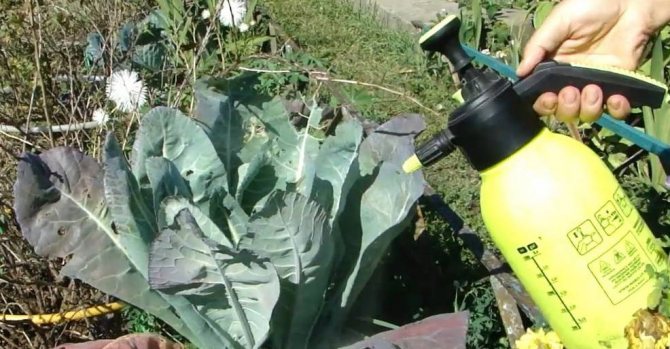

Disinsection.
Fighting the main pests with folk remedies
As you can see, cabbage has a lot of enemies. Therefore, if you want to grow a good harvest, then you need to take care of its safety and preservation throughout the entire gardening season. The first protective manipulations should be carried out immediately after planting young seedlings in open ground. Indeed, at this time, any cabbage leaf beetle can gnaw plants throughout the garden for several days.
How to protect cabbage from pests?
It is not difficult to destroy harmful insects with the help of chemicals. It is enough to spray or sprinkle the seedlings several times with a suitable insecticide. But this simple, effective method has a lot of contraindications. The fact is that there are strict regulations on the use of chemicals.
During the growing season, it is impossible to carry out more treatments than the manufacturer recommends. Usually this 1-2 times... Otherwise, the plants accumulate a lot of elements harmful to the human body. And the benefits of eating such vegetables will be much less than harm.
That is why you shouldn't forget about folk methods, which allow you to protect cabbage from gluttonous bugs and caterpillars without chemicals. Therefore, it is so important to figure out how and how to treat cabbage from pests with folk remedies.
Note! All folk, home remedies are good as prevention. Timely spraying of cabbage with herbal infusion prevents the mass dispersal of pests in the beds, and helps to protect the crop from a possible attack. But if huge colonies of insects have already appeared on the plants, then it is unlikely that it will be possible to cope with them only through the use of decoctions and infusions.
Mechanical method
For many centuries, the mechanical method of fighting harmful imago has not lost its relevance.
Setting up traps and barrage strips is the best way to get rid of bears, slugs and snails, with the help of these simple devices your landings will be protected. Bury cans or glass jars along the edge of the garden and between the rows, fill them with liquid with baits. Slugs and snails will gladly rush to such traps, smelling the aroma of beer, and bears - the smell of sunflower oil. You just have to collect and dispose of the caught pests.
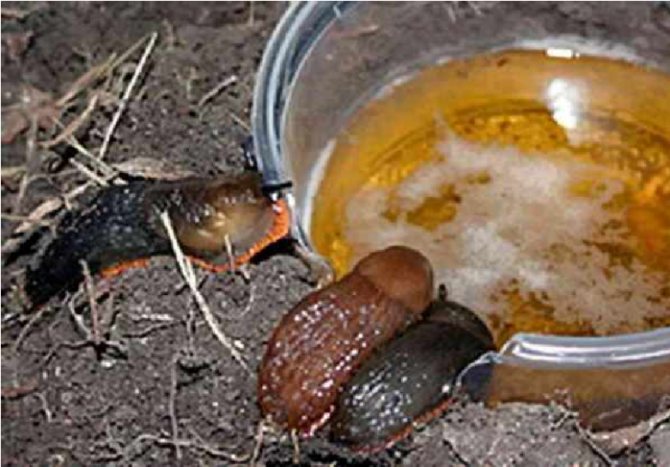

To lure slugs into a trap, it is enough to pour some beer into a buried can.
Note! If you are setting up slug and caterpillar traps, place the neck of the container flush with the ground. Pests crawling along the ground will fall into a jar filled with liquid and will not be able to get out. But if you plan to start hunting for a bear, then the container will have to be buried so that the neck is 4–5 cm below the level of the garden.
Caterpillars, adult bugs and small clusters of aphids can also be hand-picked and destroyed. This is much more effective than watering them with all kinds of broths.
Spraying
How is white cabbage, as well as cauliflower, Beijing, Brussels sprouts processed? A convenient way to apply pesticides and protective agents to plants of all varieties is by spraying. In order to avoid unpleasant consequences in the form of dryness and irritation of the skin of the hands, it is better to wear gloves before the procedure.
Tobacco
The infusion of tobacco leaves is recognized by many gardeners as almost a panacea for all gnawing and sucking individuals. To save cabbage from pests, it must be regularly sprayed with infusion of tobacco leaves.
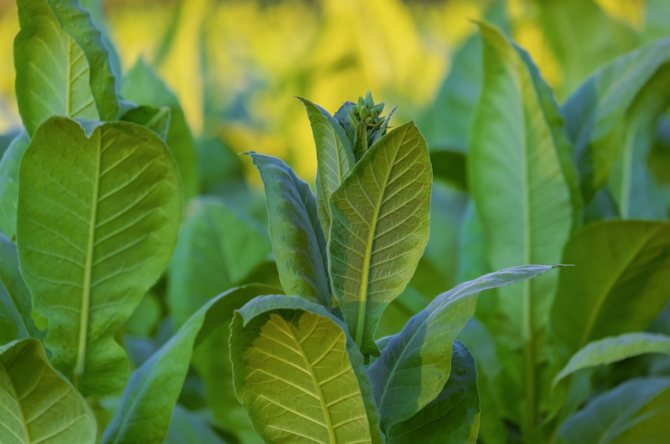

Tobacco leaves are the best way to fight cabbage pests
To prepare it, take 300 g of green leaves, chop and pour 1 liter of boiling water. Leave for 2.5-3 hours, and then strain through a linen napkin and bring the volume of liquid to 10 liters. To prevent the solution from dripping on the waxy cabbage leaves, add 2-3 tablespoons of any liquid soap to it. You can spray until the pests are completely destroyed.
Ammonia
Another equally popular remedy for cabbage pests is ammonia. A sharp, specific aroma can scare off most insects. However, the effect of such a drug has a very short-term effect. Within a few hours, not a trace of a sharp unpleasant odor remains. However, there will be no harm from such processing. After all, ammonium is the most easily assimilated form of nitrogen. The sprayed plants will quickly absorb it and begin to actively build up the vegetative mass.
The proportional ratio of the components for the preparation of an ammonia solution is 3 tablespoons of concentrated ammonia per 10 liters of water.
Tomato leaves with garlic
After pinching tomatoes, gardeners always have a lot of tomato leaves. Together with garlic arrows, they can also be used in the fight against insects.
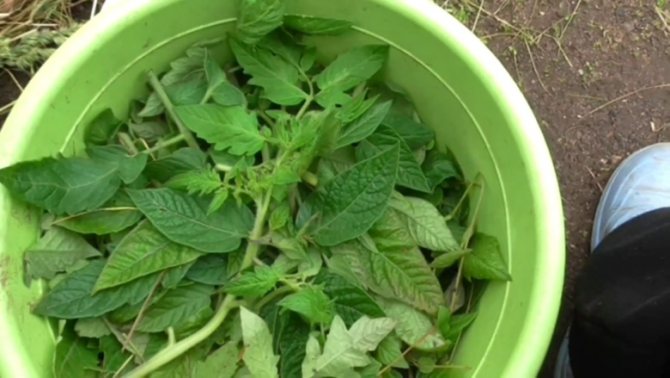

Leaves left after pinching tomatoes are ideal for combating aphids
Twist the tomato stepsons and garlic arrows, taken in the same ratio, in a meat grinder. Pour 300 g of the resulting gruel into 5 liters of water. Let it brew for 5-6 hours, then strain through a cloth. This solution can be used to spray cabbage from pests at any stage of ripening.
Valerian solution
Common valerian is able to scare off cruciferous flea beetles, scoops, whites and even aphids. But this tool also has a downside. Most likely, the pests will be replaced by cats from all over the surrounding area. If you are not afraid of such a prospect, then feel free to combine 100 ml of valerian solution (pharmacy) + 3 liters of water and start processing cabbage.
Mulching
Do you want to forget about slugs and snails forever? Then mulch the soil around the plants with a thick layer:
- broken shells;
- spruce or pine needles;
- crushed eggshell.
Thorny needles and sharp shells will prevent pests from moving around the garden. This method is also good in the fight against bears. Cabbage dwellers prefer to bypass mulched beds.
Note! Using needles on your site, you must remember that it helps to increase the acidity of the soil. If your region is characterized by soils with high acidity, be sure to monitor the pH level and, if necessary, add ash or dolomite flour.
Dusting the soil with wood ash can also help get rid of cruciferous fleas, aphids, wireworms, and cabbage flies.
Terms and rules for processing cabbage beds
Spraying cabbage beds is carried out with decoctions and infusions, chemical or biological preparations. When using toxins, a person should wear a protective suit, respirator, gloves. Immediately after the treatment of the plant with insecticides, it is impossible to weed, water, break through the area - an invisible cloud, poisonous to humans, will stand over the cabbage.
Terms of chemical treatment of beds:
- At the end of April, when the heat begins (+ 12 ... + 14 ° C), two treatments of seedlings and soil are carried out. Spraying will protect against cabbage flies, flea beetles, aphids, and will prevent leaf beetle eggs from laying.
- In early June, re-treatment protects against aphids, slugs, fleas.
- In mid-June, the last processing of the bed is carried out.
Before planting or transplanting from the greenhouse, the seedlings are examined for eggs and larvae. Each spraying is carried out in calm and cloudy weather, but there should be no rain.If one of the bushes is damaged by pests, the entire area is treated. After the heads of cabbage are set, only biological products or folk remedies are used.
Chemical treatment
Pest control on cabbage using chemicals is quite effective. The result is visible within a few hours.


When the number of pests reaches a critical level, chemicals are indispensable
If you notice too late that your beds are attacked by insects and the harm from their presence is obvious, feel free to use chemical agents to protect the cabbage.
Note! The manufacturer always indicates on the packaging the waiting period necessary for the complete disintegration of substances harmful to the human body, after which the plants can be eaten. Be sure to follow the instructions and do not exceed the recommended application rates.
- Aliot (contact insectoacaricide) against butterflies, moths and aphids.
- Antitlin (plant insecticide of contact action - tobacco dust) against aphids, moths.
- Spark M (intestinal pesticide).
- Lepidocide (bacterial insecticide, waiting period 5 days) against whiteflies, scoop.
- Fitoverm (bacterial insecticide of contact action, waiting period 3 - 5 days) against cabbage moth.
- Tsiperus and Cyclone are against the bear.
- Anti-sludge - against slugs and snails
From aphids
Cabbage aphids are harmful to young plants. You can protect vegetables from a pest in the following ways:
- Prepare a complex infusion: mix 1 cup of ash, tobacco dust and 1 tbsp. l. liquid soap, mustard. Pour a bucket of hot liquid (10 l), let it brew for a day. Strain, sprinkle the heads of cabbage with the mixture.
- Dissolve 400 g of crushed soap in 10 liters of liquid. Spray the resulting soapy water on the plants with a spray bottle.
- Make an ash-and-soap solution: pour boiling water (1 l) over ash (1 tbsp. L.), Stir and leave overnight. Strain, add liquid soap (a few drops), spray the cabbage with the product in the morning (at 5-6 o'clock), paying attention to the lower part of the leaves. The procedure should be repeated every other day.


- How to get rid of aphids on trees - treatment with chemicals and folk remedies
- How to deal with ants in a greenhouse and get rid of insects
- Hare cabbage
Pest prevention and signs
It is much easier to carry out preventive measures to prevent the massive appearance of dangerous insects on the site than to fight pests on cabbage.
Required:
- collect and destroy plant residues after the end of the garden season;
- carry out deep plowing of the site;
- observe the crop rotation.
If last season, your beds were attacked by cabbage pests, then the likelihood of their reappearance is very high. Therefore, immediately after planting seedlings in the exhaust gas, spray the plants with any protective agent and set traps for bears and slugs.
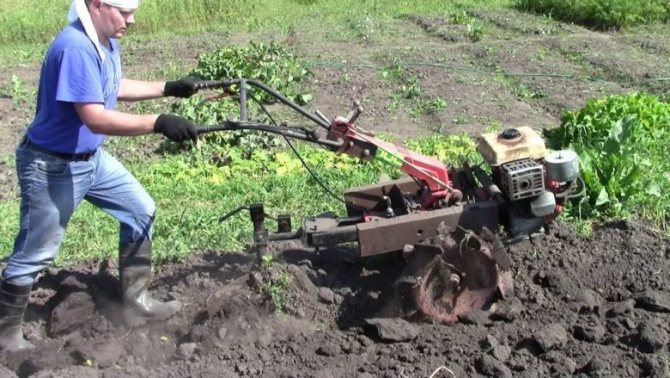

Compliance with the rules of agricultural technology - pest prevention
If, despite the observance of all agrotechnical methods and regular feeding, cabbage lags behind in growth and does not form heads, then uninvited guests have settled on it. Take a closer look at the heads, perhaps aphids, wireworms, or ticks.
Young saplings cut at the root will "tell" that a bear has appeared on the site.
Gnawed leaves, tops, heads of cabbage eaten through and many holes in all leaf blades are the result of the labor of caterpillars, slugs, cruciferous fleas. In this case, urgent processing of the cabbage is needed.
From the cabbage fly
Cabbage flies lay their eggs in the root zone of plants or in the soil, so they can only be dealt with by hindering the laying of eggs, and not by processing heads of cabbage. To do this, you need to sprinkle the earth with such folk remedies:
- Mix 1 part naphthalene and 7 parts sand, sprinkle on the soil with the mixture. Use 30 g of product per 1 sq. m.land (to enhance the effect, you can dig up).
- A similar procedure is carried out using a mixture of lime with tobacco dust, taken in equal proportions.
- Water the ground around the cabbage with clean water, and sprinkle the soil and wet cabbage leaves with ash. If it rains, repeat the procedure.
- Black ants destroy the cabbage fly larvae. To attract insects, it is necessary to place a container with a jam solution under the bush.


Cabbage neighbors for pest control
You can scare away uninvited guests with the help of plants that emit a strong aroma.


Having planted marigolds or calendula along the edge, you can forget about harmful insects
- Tansy.
- Calendula.
- Sage.
- Chamomile.
- Mint.
- Tarragon.
- Marigold.
- Nasturtium.
- Dill.
- Sagebrush.
Make it a rule to plant several bushes of these magical plants along the beds and you will save the cabbage from pests.
How to protect cabbage from hares in the country?
Hares are capable of destroying most of the crop in a few days. To protect the beds from the fluffy pest, it is not necessary to guard the site all night. A tall, sturdy hedge will help preserve all trees and plants. If it is not possible to build a fence, it is recommended to throw thorny branches of rose hips or roses along the site. Tar will also help save the cabbage, the thief does not like its smell. It is necessary to grease the boards with them and put them between the seedlings.
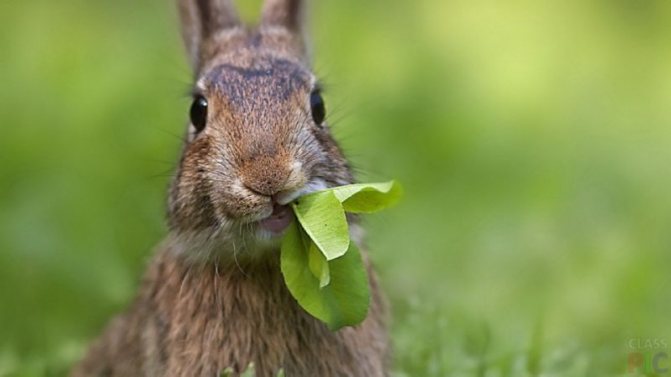

Important: some summer residents advise making a trap or a loop. But it is not humane to interfere with the population of hares by exterminating them.

